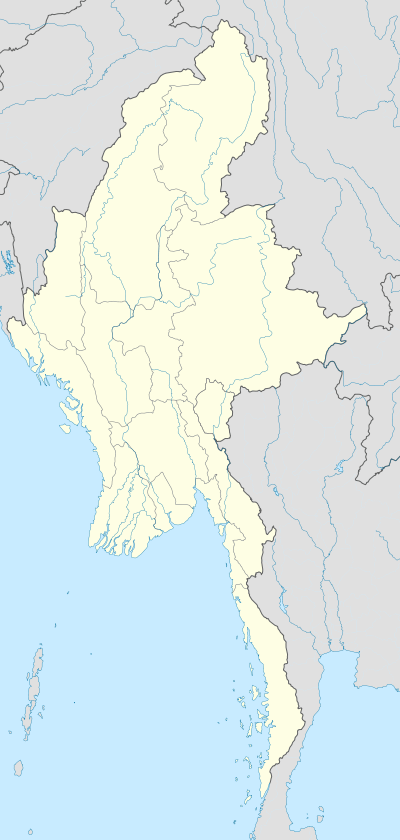Hlawga National Park
| Hlawga National Park | |
|---|---|
|
IUCN category II (national park) | |
 Location in Burma | |
| Location | Mingaladon, Yangon Region, Myanmar |
| Nearest city | Yangon |
| Coordinates | 17°00′17″N 96°06′44″E / 17.00472°N 96.11222°ECoordinates: 17°00′17″N 96°06′44″E / 17.00472°N 96.11222°E |
| Area | 1540 acres (623 hectares) |
| Established | September 30, 1982 |
| Governing body | Ministry of Environmental Conservation and Forestry |
Hlawga National Park (Burmese: လှော်ကားအမျိုးသားဥယျာဉ်) is a national park located in Mingaladon, Yangon Division, Myanmar, 22 miles (35 km) north of Yangon. The 1540-acre (623-hectare) park includes an 818-acre (313 hectare) wildlife park, a 62-acre (25-hectare) mini-zoo and a 660-acre (267-hectare) buffer zone.[1]
First established as an environmental education center in 1982, the national park is a popular day-trip destination with Yangonites and ecotourists.
History
The park embraces the catchment area of the Zokanabe Lake, an extension dam built in 1921–24 to reinforce the greater Hlawga Lake which has supplied water to Yangon since 1904. The park was established in 1982 with joint-funding by the UNDP and the Burmese government[2] in order to protect the forests and vegetative cover in the catchment of Hlawga Lake, and to establish a representative collection of Burmese indigenous wildlife species of mammals, reptiles and birds, in their natural habitats.[1]
Attractions
Wildlife
The 818-acre (3.31 km2) wildlife park is home to various types of deer (eld's deer, hog deer, barking deer, sambar deer), as well as rhesus monkey, pythons, and pangolin.[1] Their natural habitats consists of semi-evergreen forests, mixed deciduous forests, and swamp forests. According to a 1992 survey, the park was home to at least 21 species of mammals, 145 species of birds and 8 species of reptiles.[2]
Barking deer, hog deer and wild boar are the most common mammal species. Slow lores, pangolin and a few species of jungle cats used to roam the park at night feeding on figs, which is abundantly found in the park. The semi-evergreen type of vegetation creates ideal habitats for a variety of reptiles from monitor lizards to cobra, and krait ( Bungarus fasciatus) to pythons (Python reticulatus).[2]
Birds
Resident and migratory birds are abundant inside the park. Identified species include: the jungle fowl (Gallus gallus), red-vented bulbul (Pycnonotus cafer), lesser whistling duck (Dendrocygna javanica), Asian openbill stork (Anastomus oscitans), black-crowned night heron (Nycticonax nycticorax) and white-throated babbler (Turdoides gularis).[2]
Flora
The evergreen forest contains at least 295 species of plants. Common species are dipterocarps and Lagerstroemia speciosa. Also found are deciduous species such as teak (Tectona grandis) and binga (Mitragyna rotundifolia), and medicinal plants such as sindonma-nwe (Tinospora cordifolia).[2]
Mini-zoo
The mini-zoo has small mammals, birds, tigers, leopards, bears and estuarine crocodiles in large spacious cages, avaries and moated enclosures.[1]
Activities
Visitors can go on a safari-style bus ride or an elephant ride through the park, hiking on jungle trails, boating on the lake, and/or bird watching.[2] However, most local visitors use the park's picnic areas.
The park is divided into three zones: a rest and retreat zone, an adventure and recreation zone, and an education and hobby zone. The rest and retreat zone features forest eco-lodges, boat houses and a health spa resort. The adventure and recreation zone has facilities for jungle trekking, bird watching and wild life safaris, as well as a camping ground and training areas for mountain climbing and parachuting. The education and hobby zone includes a timber species display center, a butterfly park, an insect kingdom, a reptile park and fishing spots.[3]
Climate
Located in coastal Yangon Division, the park has a monsoonal climate. Annual average rainfall is about 95 inches (240 cm) most of which is received between late May and October. The coolest months are from November to February (average high: 32C and average low: 18C) and the hottest months are from March to May (average high: 37C and average min: 24C). The mean relative humidity is 87%.
References
- 1 2 3 4 "Hlawga Park". Retrieved 2009-09-28.
- 1 2 3 4 5 6 Zaw Gyi (Lawk Sauk) (1996-01-01). "Hlawga Park of Myanmar". Myanmar Perspectives. Retrieved 2008-09-29.
- ↑ Jasmin Saw (2003-02-24). "Program to re-develop Hlawga National Park". The Myanmar Times.